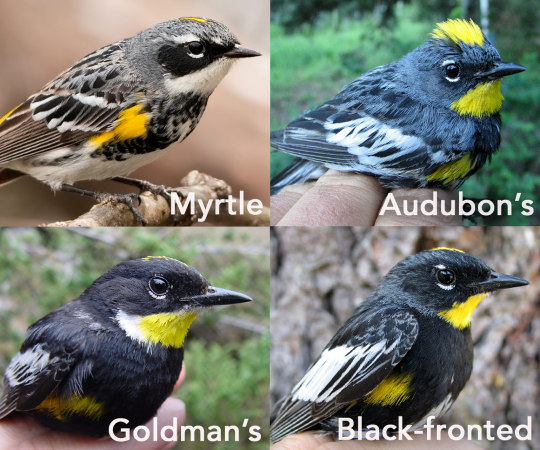#for the purpose of the bird poll I am treating them as separate species
Explore tagged Tumblr posts
Text
Yellow-rumped Warbler (Setophaga coronata)
There are (currently) four subspecies within Setophaga coronata:
Myrtle Warbler (S.c. coronata)
Audubon's Warbler (S.c. auduboni)
Black-fronted Warbler (S.c. nigrifrons)
Goldman's Warbler (S.c. goldmani)

Our story (my rambling) begins with Myrtle and Audubon's Warblers being described as separate species, until a study in 1973 found evidence that the two routinely hybridized within a small strip of Western Canada. The Biological Species Concept* defines a species as any members of a population which can interbreed and create fertile offspring, and with the limited genetic evidence of the time, this concept was used to lump Myrtle and Audubon's into the Yellow-rumped Warbler. (*keep in mind there are many ways to define a species, so this single concept isnt a "be all, end all" argument)
This hybrid zone, however, is only 80 miles across, and has been shown to be stable over the past 50 years, suggesting the hybrids may not be as viable as previously thought. This, coupled with a new and overwhelming comparison between the birds' genomes, suggests that Myrtle and Audubon's Warblers are indeed separate species.
So the story goes back even further, because this story is really about bird populations and not our human ability to categorize them. The most likely situation is that the Myrtle Warbler was separated from the other three forms of the species during the Pleistocene glaciation, over the last million years or so. This pattern can also be seen in other "paired" species from East to West, such as Baltimore and Bullock's Orioles, or Rose-breasted and Black-headed Grosbeaks. The glaciers cut off the breeding population of Myrtle Warblers, and only after their receding could they move West to meet in the middle again.
In an interesting twist, the leading idea is that Audubon's Warbler is not only a separate species, but is actually a hybrid species which arose from Myrtle meeting the Black-fronted Warbler once it expanded back West. This hypothesis is supported by mitochondrial DNA of a sedentary population of Audubon's being very similar to Black-fronted, rather than to Myrtle Warblers. There needs to be more study into the genomics of these birds to confirm whether or not Audubon's would stand as it's own species, or if it and Black-fronted are more closely related.
Off to the side of all this is Goldman's Warbler, which makes sense when you take a look at the breeding range of these warblers. Black-fronted and Goldman's Warbler are both non-migratory birds, and the population of Goldman's Warbler is located almost entirely in Guatemala, with possible populations to the west in Chiapas, Mexico. In the same genomics study above, Goldman's Warbler stood out as unique when compared to both Myrtle and Audubon's DNA.

To sum this up: more study is needed between Myrtle, Audubon's, and Black-fronted to confirm previous findings, but a three-way species split from this single species seems to be supported. The International Ornithological Congress (IOS) has already done so, splitting Yellow-rumped Warbler into Myrtle, Audubon's (with Black-fronted as a subspecies), and Goldman's Warbler.
While we're on the topic- hybridization between Setophaga warblers is not unheard of, and Yellow-rumped Warbler has multiple documented hybrids in the Macaulay library. I won't post all the pictures, but the best are linked as follows: Cape May, Magnolia, Palm, Yellow-throated, Grace's, Townsend's, Hermit, Black-throated Green). Other than it's own species-complex, Yellow-rumps are most closely related to Yellow-throated and Bahama Warbler.
Sources Below
Wikipedia (for ease of summarization)
Birds of the World (for the more in-depth story)
Barry the Birder (for the compiled image of all four birds, and for talking about the All About Birds article so I could find and link that)
All About Birds (for the range-pic, and for summarizing the study from The Auk- way better than I did, I may add. Go read their article if this intrigued you.)
Papers cited in Birds of the World:
[on 'lumping' YRWA] Eisenmann, E. (1973). Thirty-second supplement to the American Ornithologists' Union check-list of North American birds. Auk 90: 411–419.
[on the hybrid zone] Hubbard, J. P. (1969). The relationships and evolution of the Dendroica coronata complex. Auk 86:393-432.
[hybrid zone] Barrowclough, G. F. (1980). Genetic and phenotypic differentiation in a wood warbler (genus Dendroica) hybrid zone. Auk 97:655-668.
[hybrid zone] Brelsford, A., and D. E. Irwin (2009). Incipient speciation despite little assortative mating: the Yellow-rumped Warbler hybrid zone. Evolution 63:3050-3060
[on mtDNA between auduboni and nigrifrons] Milá, B., Toews, D.P.L., Smith, T.B. and Wayne, R.K. (2011). A cryptic contact zone between divergent mitochondrial DNA lineages in southwestern North America supports past introgressive hybridization in the yellow-rumped warbler complex (Aves: Dendroica coronata). Biological Journal of the Linnean Society. 103: 696–706.
[on the 'hybrid origin' of auduboni] Brelsford, A., Milá, B. and Irwin, D.E. (2011). Hybrid origin of Audubon’s Warbler. Molecular Ecology. 20(11): 2380–2389.
[on 'splitting' YRWA] Toews, D.P.L., Brelsford, A., Grossen, C., Milá, B. and Irwin, D.E. (2016). Genomic variation across the Yellow-rumped Warbler species complex. Auk. 133(4): 698–717.
#setophaga#parulidae#passeriformes#birds#north american birds#american birds#yellow rumped warbler#audubon's warbler#myrtle warbler#goldmans warbler#for the purpose of the bird poll I am treating them as separate species#it helped round out the numbers and made showcasing them a bit easier lol
18 notes
·
View notes